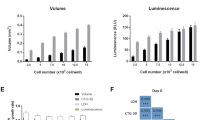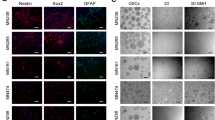Abstract
To better understand melanoma resistance to herpes simplex virus type 1 (HSV-1)-mediated oncolysis, traditional two-dimensional (2D) cultures and extracellular matrix (ECM) containing three-dimensional (3D) cultures of OCM1 and C918 uveal melanoma cells were infected with an HSV-1 strain that expresses the green fluorescent protein (GFP) marker during replication. Although 2D cultures were completely destroyed within a few days of HSV-1 inoculation, viable GFP-negative tumor cells remained detectable in 3D cultures for several weeks. Tumor cells with increased resistance to HSV-1 included cells that formed vasculogenic mimicry patterns and multicellular spheroids and cells that invaded Matrigel individually. Mechanisms of tumor resistance against HSV-1 in the 3D environment included impaired virus spread in the ECM and ECM-mediated inhibition of viral replication after viral entry into tumor cells. Observations also suggested that HSV-1 established quiescent infection in some tumor cells present in multicellular spheroids and that this could revert to productive viral infection when the tumor growth pattern changed. These findings indicate that 3D tumor cell cultures can be used to identify distinct tumor cell populations with increased resistance to HSV-1 and to explore mechanisms of ECM-mediated tumor resistance to oncolytic virotherapy.
This is a preview of subscription content, access via your institution
Access options
Subscribe to this journal
Receive 12 print issues and online access
$259.00 per year
only $21.58 per issue
Buy this article
- Purchase on Springer Link
- Instant access to full article PDF
Prices may be subject to local taxes which are calculated during checkout







Similar content being viewed by others
References
Guo SZ, Thorne SH, Bartlett DL . Oncolytic virotherapy: molecular targets in tumor-selective replication and carrier cell-mediated delivery of oncolytic viruses. Biochim Biophys Acta 2008; 1785: 217–231.
Liu TC, Kirn D . Gene therapy progress and prospects cancer: oncolytic viruses. Gene Ther 2008; 15: 877–884.
Latchman DS . Herpes simplex virus-based vectors for the treatment of cancer and neurodegenerative disease. Curr Opin Mol Ther 2005; 7: 415–418.
MacKie RM, Stewart B, Brown SM . Intralesional injection of herpes simplex virus 1716 in metastatic melanoma. Lancet 2001; 357: 525–526.
Shen Y, Nemunaitis J . Herpes simplex virus 1 (HSV-1) for cancer treatment. Cancer Gene Ther 2006; 13: 975–992.
Varghese S, Rabkin SD . Oncolytic herpes simplex virus vectors for cancer virotherapy. Cancer Gene Ther 2002; 9: 967–978.
Chiocca EA . The host response to cancer virotherapy. Curr Opin Mol Ther 2008; 10: 38–45.
Benecia F, Courreges MC, Fraser NW, Coukos G . Herpes virus oncolytic therapy reverses tumor immune dysfunction and facilitates tumor antigen presentation. Cancer Biol Ther 2008; 7: 1194–1205.
Fukuhara H, Todo T . Oncolytic herpes simplex virus type 1 and host immune responses. Curr Cancer Drug Targets 2007; 7: 149–155.
Miller CG, Fraser NW . Requirement of an integrated immune response for successful neuroattenuated HSV-1 therapy in an intracranial metastatic melanoma model. Mol Ther 2003; 7: 741–747.
Toda M, Rabkin SD, Kojima H, Martuza RL . Herpes simplex virus as an in situ cancer vaccine for the induction of specific anti-tumor immunity. Hum Gene Ther 1999; 10: 385–393.
Guzman G, Oh SD, Shukla D, Valyi-Nagy T . Nectin-1 expression in the normal and neoplastic human female gynecologic tract. Arch Pathol Lab Med 2006; 130: 1191–1195.
Guzman G, Oh SD, Shukla D, Engelhard HH, Valyi-Nagy T . Expression of entry receptor nectin-1 of Herpes simplex virus 1 and/or Herpes simplex virus 2 in normal and neoplastic human nervous system tissues. Acta Virol 2006; 50: 59–66.
Kolodkin-Gal D, Zamir G, Edden Y, Pikarsky E, Pikarsky A, Haim H et al. Herpes simplex virus type 1 preferentially targets human colon carcinoma: role of extracellular matrix. J Virol 2008; 82: 999–1010.
McKie TD, Grandi P, Mok W, Alexandrakis G, Insin N, Zimmer JP et al. Degradation of fibrillar collagen in a human melanoma xenograft improves the efficacy of an oncolytic herpes simplex virus vector. Cancer Res 2006; 66: 2509–2513.
Nagano S, Perentes JY, Jain RK, Boucher Y . Cancer cell death enhances the penetration and efficiency of oncolytic herpes simplex virus in tumors. Cancer Res 2008; 68: 3795–3802.
Rueger MA, Winkeler A, Miletic H, Kaestle C, Richter R, Schneider G et al. Variability in infectivity of primary cell cultures of human brain tumors with HSV-1 amplicon vectors. Gene Ther 2005; 12: 588–596.
Yu Z, Adusumilli PS, Eisenberg DP, Darr E, Ghossein RA, Li S et al. Nectin-1 expression by squamous cell carcinoma is a predictor of herpes oncolytic sensitivity. Mol Ther 2007; 15: 103–113.
Yun CO . Overcoming the extracellular matrix barrier to improve intratumoral spread and therapeutic potential of oncolytic virotherapy. Curr Opin Mol Ther 2008; 10: 356–361.
Abbott A . Biology's new dimension. Nature 2003; 424: 870–872.
Friedrich MJ . Studying cancer in 3 dimensions. JAMA 2003; 290: 1977–1979.
Ghosh S, Spagnoli GC, Martin I, Ploegert S, Demougin P, Heberer M et al. Three-dimensional culture of melanoma cells profoundly affects gene expression profile: a high density oligonucleotide array study. J Cell Physiol 2005; 204: 522–531.
Smalley KS, Lioni M, Herlyn M . Life isn’t flat: taking cancer biology to the next dimension. In vitro Cell Dev Biol Anim 2006; 42: 242–247.
Nelson CM, Bissell MJ . Modeling dynamic reciprocity: engineering three-dimensional culture models of breast architecture, function, and neoplastic transformation. Semin Cancer Biol 2005; 15: 342–352.
Xu F, Burg KJL . Three-dimensional polymeric systems for cancer cell studies. Cytotechnology 2007; 54: 135–143.
Schmeichel KL, Bissell MJ . Modeling tissue-specific signaling and organ function in three dimensions. J Cell Sci 2003; 116: 2377–2388.
Schmidmaier R, Baumann P . Anti-adhesion evolves to a promising therapeutic concept in oncology. Curr Med Chem 2008; 15: 978–990.
Wang F, Weaver VM, Petersen OW, Larabell CA, Dedhar S, Briand P et al. Reciprocal interactions between beta1-integrin and epidermal growth factor receptor in three-dimensional basement membrane breast cultures: a different perspective in epithelial biology. Proc Natl Acad Sci USA 1998; 95: 14821–14826.
Weaver VM, Petersen OW, Wang F, Larabell CA, Briand P, Damsky C et al. Reversion of the malignant phenotype of human breast cells in three-dimensional culture and in vivo by integrin blocking antibodies. J Cell Biol 1997; 137: 231–245.
Jacks T, Weinberg RA . Taking the study of cancer cell survival to a new dimension. Cell 2002; 111: 923–925.
Vescio RA, Redfern CH, Nelso TJ, Udoretz S, Stern PH, Hoffman RM . In vivo-like drug responses of human tumors growing in three-dimensional gel-supported primary culture. Proc Natl Acad Sci USA 1987; 84: 5029–5033.
Shimony N, Gorodetsky R, Marx G, Gal D, Rivkin R, Ben-Ari A et al. Fibrin microbeads (FMB) as a 3D platform for kidney gene and cell therapy. Kidney Int 2006; 69: 625–633.
Valyi-Nagy K, Folberg R, Valyi-Nagy T, Maniotis AJ . Susceptibility of uveal melanoma to herpes simplex virus type 1: the role of tumor invasiveness, the extracellular matrix and chromatin sequestration. Exp Eye Res 2007; 84: 991–1000.
Folberg R, Hendrix MJ, Maniotis AJ . Vasculogenic mimicry and tumor angiogenesis. Am J Pathol 2000; 156: 361–381.
Folberg R, Arbieva Z, Moses J, Hayee A, Sandal T, Kadkol S et al. Tumor cell plasticity in uveal melanoma—microenvironment directed dampening of the invasive and metastatic genotype and phenotype accompanies the generation of vasculogenic mimicry patterns. Am J Pathol 2006; 169: 1376–1389.
Folberg R, Leach L, Valyi-Nagy K, Lin AY, Apushkin MA, Ai Z et al. Modeling the behavior of uveal melanoma in the liver. Invest Ophthalmol Vis Sci 2007; 48: 2967–2974.
Folberg R, Maniotis AJ . Vasculogenic mimicry. APMIS 2004; 112: 508–525.
Maniotis AJ, Folberg R, Hess A, Seftor EA, Gardner LMG, Pe’er J et al. Vascular channel formation by human melanoma cells in vivo and in vitro: vasculogenic mimicry. Am J Pathol 1999; 155: 739–752.
Maniotis AJ, Valyi-Nagy K, Karavitis J, Moses J, Boddipali JV, Wang Y et al. Chromatin organization measured by Alu I restriction enzyme changes with malignancy and is regulated by the extracellular matrix and the cytoskeleton. Am J Pathol 2005; 166: 1187–1203.
Desai P, Pearson S . Incorporation of the green fluorescent protein into the herpes simplex virus type 1 capsid. J Virol 1998; 72: 7563–7568.
Akhtar J, Tiwari V, Oh M, Kovacs M, Jani A, Kovacs SK et al. HVEM and nectin-1 are the major mediators of herpes simplex virus 1 (HSV-1) entry into human conjunctival epithelium. Invest Ophthalmol Vis Sci 2008; 49: 4026–4035.
Folberg R, Kadkol S, Frenkel S, Valyi-Nagy K, Jager MJ, Pe’er J et al. Authenticating cell lines in ophthalmic research laboratories. Invest Ophthalmol Vis Sci 2008; 49: 4697–4701.
Weeks BS, Ramchandran RS, Hopkins JJ, Friedman HM . Herpes simplex virus type-1 and -2 pathogenesis is restricted by the epidermal basement membrane. Arch Virol 2000; 145: 385–396.
Weaver VM, Lelievre S, Lakins JN, Chrenek MA, Jones JC, Giancotti F et al. Beta4 integrin dependent formation of polarized three-dimensional architecture confers resistance to apoptosis in normal and malignant mammary epithelium. Cancer Cell 2002; 2: 205–216.
Preston CM . Repression of viral transcription during herpes simplex virus latency. J Gen Virol 2000; 81: 1–19.
Valyi-Nagy T, Shukla D, Engelhard HH, Kavouras J, Scanlan P . Latency strategies of alphaherpesviruses: herpes simplex virus and varicella-zoster virus latency in neurons. In: Minarovits J, Gonczol E, Valyi-Nagy T (eds). Latency Strategies of Herpesviruses. Springer: New York, 2007. pp 1–36.
Acknowledgements
This work was supported by fellowship grants to SD, SKK, SB, and AV by the Rosztoczy Foundation and by Public Health Service grant EY10457 to RF. RF is currently with Oakland University William Beaumont School of Medicine.
Author information
Authors and Affiliations
Corresponding author
Rights and permissions
About this article
Cite this article
Valyi-Nagy, K., Dosa, S., Kovacs, S. et al. Identification of virus resistant tumor cell subpopulations in three-dimensional uveal melanoma cultures. Cancer Gene Ther 17, 223–234 (2010). https://doi.org/10.1038/cgt.2009.73
Received:
Revised:
Accepted:
Published:
Issue Date:
DOI: https://doi.org/10.1038/cgt.2009.73



